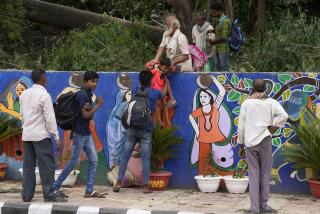India Car Bombs Kill 45
- Share via
NEW DELHI — Two car bombs rocked India’s commercial capital of Bombay during lunchtime Monday, turning the area around a jewelry market and a historical landmark into a war zone.
At least 45 people were killed and more than 150 were wounded in the successive blasts, which were so powerful that some pedestrians were hurled over walls into the sea. Television broadcast images of body parts on promenades. Blast-damaged buildings leaned precariously.
There were no immediate claims of responsibility, but authorities blamed Muslim groups including the Lashkar-e-Taiba and the Student Islamic Movement of India. Both organizations, which have been banned in mostly Hindu India for past terrorist attacks, seek independence for the Indian-held part of Kashmir, a mostly Muslim region.
Local officials initially blamed “the enemy country,” a clear reference to India’s longtime rival and fellow nuclear power, Pakistan.
However, national officials, who are attempting some reconciliation with the Muslim country, were more cautious.
And in contrast to their silence following other attacks, Pakistani officials immediately denounced the bombings.
“We deplore these attacks,” Pakistani Foreign Ministry spokesman Masood Khan said, calling them “wanton targeting of civilians.”
President Bush also condemned the attacks, as did Secretary of State Colin L. Powell. Powell telephoned Indian Foreign Minister Yashwant Sinha to voice his outrage and extend condolences to the Indian government and people.
The bombings occurred as archeologists submitted their report on the origins of a religious site in Ayodhya that has been the scene of violence between Muslims and Hindus.
Thousands of people have died since the 1990s in fighting over whether the site, about 350 miles east of New Delhi, should have a mosque -- as it did from the 16th century until 1992 -- or a Hindu temple on what Hindus see as the traditional birthplace of the god Ram, or Rama.
The report indicated that there had been an ancient structure at the site, lawyers for both sides said, although they disagreed on whether it said there had actually been a temple.
Violence between Hindus and Muslims has plagued the subcontinent since India and Pakistan were carved out of the remnants of the British empire in 1947.
In addition to sectarian violence, India and Pakistan have fought three wars over the fate of the Kashmir region, which both nations claim but have been forced to divide. The countries came close to fighting a fourth war last year, but diplomats around the world worked to restrain a conflict.
Tensions have been especially acute since both countries began testing nuclear weapons in recent years.
Bombay has been the scene of at least three deadly bombings since December. More than a dozen people were killed in those attacks.
Monday’s incidents, however, were reminiscent of March 12, 1993, when 13 massive explosions shattered the city’s calm within half an hour and later sparked a violent riot between Hindus and Muslims. Those blasts, which killed 257 people and injured more than 700, struck several prominent Bombay neighborhoods, including the streets where the Bombay Stock Exchange and the passport office were located.
According to police, both of Monday’s bombs were hidden inside the trunks of taxis. They were detonated within 15 minutes of each other starting at about 12:50 p.m.
The first blast occurred on Dhanji Street at Zaveri Bazaar, a jewelry and precious metals market located in the south of the city.
Another explosion followed in a parking lot in the vicinity of the Gateway of India, one of India’s most famous landmarks, commemorating the 1911 visit by British King George V. In addition to being a prime tourist spot, the massive arch is a popular al fresco lunch spot for Muslims and Hindus.
Though the first blast at the market inflicted the most casualties, the second was more dramatic, throwing bystanders into the sea.
The blasts smashed vehicles and shattered windowpanes in the plush turn-of-the-century Taj Mahal Hotel, shaken witnesses said.
Anil Punjabi, owner of TT Jewelers -- an outlet just 30 feet from where the car bomb was planted -- said he was sitting in his office when the earth under him shook.
“After a loud bang, my showcase glass shattered and pearl ornaments flung out of our shop onto the road,” the merchant said.
Punjabi and his workers ran out of the shop and saw billowing smoke and scattered bodies.
One of the cameramen at the Gateway of India -- they take instant photographs of tourists for a living -- captured the initial moments after the blast. Journalists said the pictures showed bodies in traditional dress strewn along the seaside.
Those tourists had reportedly come to Bombay, the capital of Maharashtra state, after attending the Kumbh Mela -- an important Hindu religious event -- in nearby Nasik. Television channels beamed footage of sandals left behind by those fleeing from the scene. A trail of blood bore witness to the tragedy.
At Zaveri Bazaar, verandas were reportedly giving way on a building near the blast. All the occupants, mostly workers from the eastern Indian province of Bengal who make ornaments in small workshops, were evacuated.
Sushil Kumar Shinde, chief minister of Maharashtra state, said the explosions had targeted the city’s economy.
“The blasts have thrown up a challenge to the resilience of this city,” he told a news conference.
Stock prices plunged after the attacks. The benchmark index of the Bombay Stock Exchange, the Sensex, fell 3% to close at 4,005.
Times wire services were used in compiling this report.
More to Read
Sign up for Essential California
The most important California stories and recommendations in your inbox every morning.
You may occasionally receive promotional content from the Los Angeles Times.













